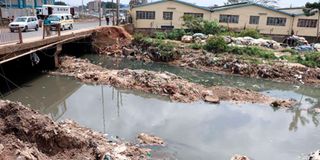This is how to end pollution of city rivers

Garbage dumped in a section of Ngong River, Mukuru kwa Njenga slums in Nairobi in this picture taken on May 23, 2021.
What you need to know:
- Most discharge into Nairobi River and the Athi Basin mostly comes from the old sewerage trunking system in Nairobi City County that now and then fails.
- It is time to encourage factories that have space to create wetlands where their polluted waste water would be cleansed before being released.
The pollution that goes on on water bodies in Nairobi is mostly enabled by the city residents, who intentionally discharge waste water and raw sewage into rivers and streams.
While commissioning Thwake River Dam, which is expected to greatly improve agricultural activity in Makueni County and other parts of the vast Ukambani region, President Uhuru Kenyatta was told that River Thwake is heavily polluted because it draws its water from Nairobi River, which passes through the city.
Most discharge into Nairobi River and the Athi Basin mostly comes from the old sewerage trunking system in Nairobi City County that now and then fails, leading to blocked manholes, which, in turn, spew raw sewage into the water bodies. Sewerage coverage is low, compared with the population growth in the capital city over the years. This should be prioritised.
Informal settlements in Nairobi are also a major source of pollution to water bodies, especially the Ngong and Nairobi rivers. So long as they are located along riparian areas, downstream residents will never have clean water.
Cleaning Nairobi River
Relocating them would be a big step in cleaning Nairobi River. Garages, makeshift restaurants and shops (kiosks) and discharge from factories in Industrial Area are also main pollutants. Garbage is also dumped in the rivers. This has to be abated.
It is time to encourage factories that have space to create wetlands where their polluted waste water would be cleansed before being released. Although the National Environment Management Authority (Nema) — in collaboration with Water Resources Authority and the Nairobi County government — is making efforts in enforcement, residents should discharge their sewage and waste water into the sewer system.
Buildings and slums along riparian areas should be removed. Most informal settlements have pit latrines beside rivers, which is wrong.
These measures, if properly implemented, will go a long way in cleansing the water bodies that pass through commercial and residential areas in Nairobi and Machakos counties.
Mr Kigo is an environment officer. [email protected].





